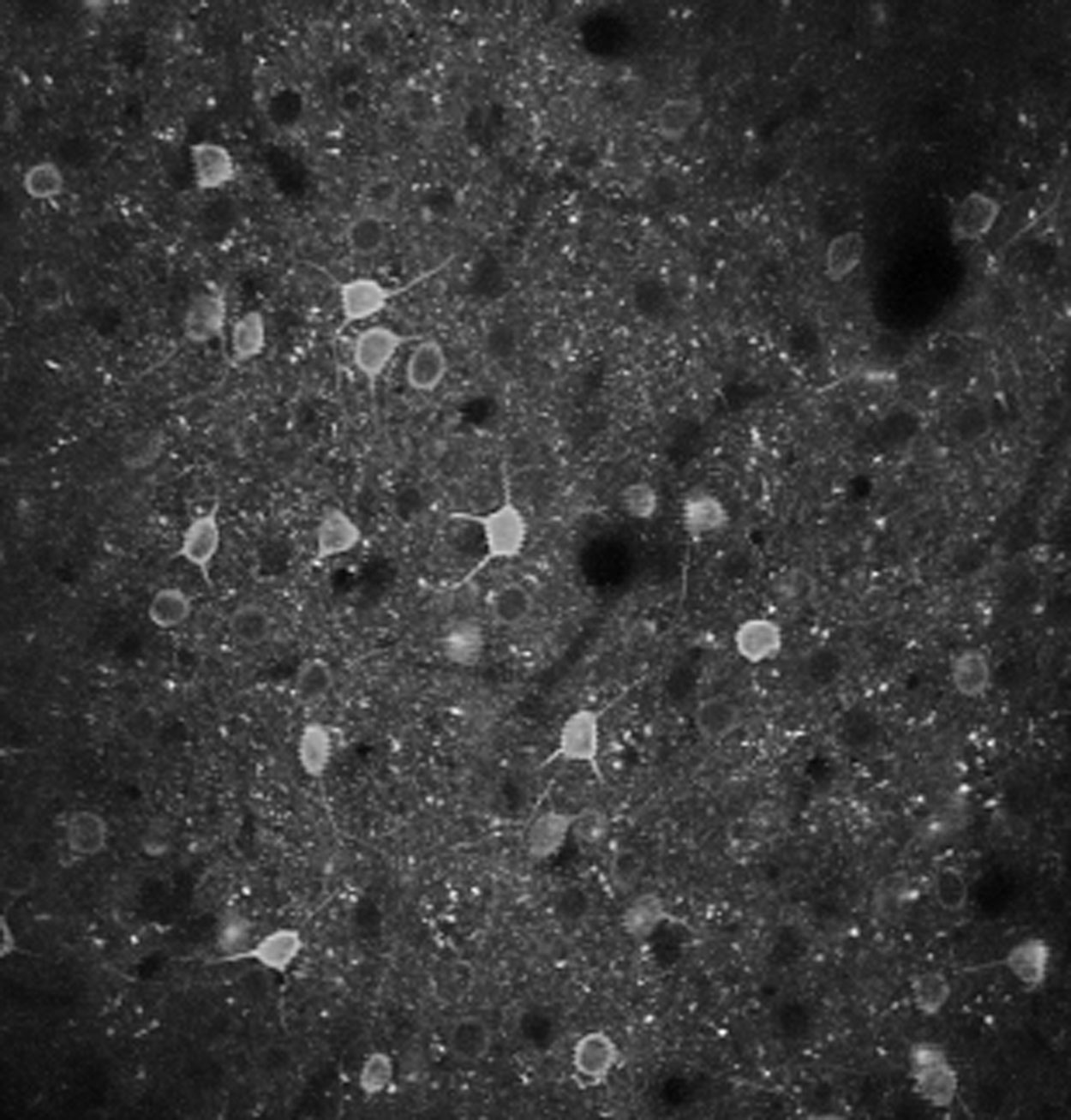UC San Diego neurobiologist part of $2 million project to study brain, motor-skill learning
Researchers to develop neuronal circuit simulator, could lead to smarter computers and new treatments for memory loss
December 17, 2019
By Cory Nealon, University at Buffalo

In an area spanning 300 by 300 micrometers, this image highlights neurons in the motor cortex captured while a mouse performs a lever-pressing task. The brighter neurons were actively firing when the image was taken.
Komiyama Lab, UC San Diego
If you think of the human brain as a computer, it’s hard not to be impressed.
It can perform well over a trillion logical operations per second. It’s compact, fitting neatly inside the skull. It uses as much power as a light bulb, and it has a seemingly endless capacity for data storage.
Despite massive investment in recent years, humanity’s knowledge of the brain, which has about 86 billion neurons and more than a quadrillion synapses (or connections), is relatively limited.
To better understand the organ, a University at Buffalo-led research team has been awarded a $2 million National Science Foundation grant to build an interdisciplinary research program that explores how the brain learns and stores information.
“Our brains provide us with near-infinite capacity to learn and better understand our world, yet it’s the organ that we know least about,” says the project’s lead investigator Rudiyanto Gunawan, associate professor of chemical and biological engineering in the UB School of Engineering and Applied Sciences.
Gunawan says the project could ultimately inspire new computer architectures, leading to more powerful and efficient supercomputers, as well as new treatments for disorders responsible for memory loss, such as Alzheimer’s disease.
“Establishing a truly brain-like platform would have a massive impact,” said Takaki Komiyama, a professor of neurobiology (Division of Biological Sciences) and neurosciences (Department of Neurosciences, School of Medicine) at the University of California San Diego. “For neuroscience, that could be a unique system on which we can perform precise manipulation experiments at will to understand the critical features of brain circuits. The platform could also be developed into neuromorphic computing and data storage devices.”
Co-principal investigators (in alphabetical order) also include Claudia Mewes, associate professor in the Department of Physics and Astronomy at the University of Alabama; Linbing Wang professor of transportation infrastructure and systems engineering in the Charles E. Via, Jr. Department of Civil and Environmental Engineering at Virginia Tech; and Ying Zhang, associate professor of cell and molecular biology in the College of Environment and Life Sciences at University of Rhode Island.
Team to develop “neuromorphic platform”
The team will focus on the motor cortex, a portion of the brain responsible for the planning, control and execution of voluntary movements. Research in this region of the brain in mice has shown neuronal activity associated with motor skill learning.
When presented with a new task, the firing of connections between neurons appears random. As the task is repeated, neuronal activity in this second phase of learning spikes. That is followed by a third phase in which a consistent pattern of neuronal activity emerges that is unique for each mice.
“As the brain learns, it finds the most efficient networks to process and store information,” says Gunawan. “We want to know how this happens so we can incorporate this knowledge into artificial devices that will help us solve some of society’s most pressing problems.”
To accomplish this, researchers are planning what’s been described as a “neuromorphic platform,” which essentially is a system that simulates the brain, or parts of it.
The platform the team intends to create will focus on hundreds of neurons. Eventually, the researchers hope to expand this model to 10,000 neurons.
AI and spintronics
There has been an explosion of neuroscience data in recent years — thanks to major initiatives underway in the U.S., Europe, Japan and elsewhere — that will aid the team’s work.
The team will develop artificial intelligence algorithms to analyze countless microscopic images and single neuron molecular profiles that have been generated from brain networks in mice.
From these data, researchers plan to create large-scale biochemical models which illustrate neuronal activity. To further validate and emulate how neurons behave, the team also plans to develop a spintronic device that’s capable of producing complex computer simulations of brain activity.
The overarching goal, Gunawan says, is to create a multidisciplinary and robust platform for studying the brain. This could lead to brain-inspired devices for information processing, data storage, computing and decision-making.
“The human brain is roughly 12 orders of magnitude more efficient than state-of-the-art supercomputers. Imagine if we could translate that efficiency in computer architectures,” he says.
While advanced supercomputing has endless possibilities, especially as it relates to medicine and pharmaceuticals, the platform itself could be beneficial for researchers studying brain disorders, he says.
“The ability to accurately simulate neuronal activity — as it relates to memory loss, cognition and other behaviors — is of paramount importance to developing new treatments for many of the most devastating neurological disorders facing society,” he says.
